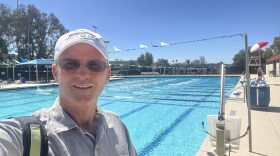Recovering from a spinal cord injury can be extremely difficult. Physical therapy and other interventions can help. But despite those efforts, some people are left with paralyzed or spastic limbs.
In July 2008, Rick Constantine was involved in a head-on car crash in Las Vegas. The accident left him paralyzed on his right side.
Despite surgery to ease the pressure on his spine, and numerous physical therapy sessions, his condition just didn’t improve much. Doctors told Constantine he’d never walk again.
But they were wrong.
Constantine not only can get up out of his wheelchair under his own power, he can also walk without a cane.
In August 2005, Steve Isetts was riding his mountain bike in Escondido’s Daley Ranch. He swerved to dodge something on the trail, and wiped out.
The accident damaged three vertebrae. Surgeons put in four plates and a dozen screws.
After the crash, Isetts had little control over his left leg.
And now?
The secret to Isetts’ and Constantine’s recovery is a unique type of surgery called selective peripheral neurotomy.
It’s performed on people who have paralyzed, or severely spastic limbs. The surgery cuts out parts of the nerves that are causing the most interference with proper movement, while leaving the healthy parts of the nerves, and all of the muscles, intact.
UC San Diego Neurosurgeon Justin Brown trained in France with one of the pioneers of the procedure. Dr. Brown is one of the only practitioners of it in the U.S.
He said there are several advantages of the surgery, compared with the standard treatment of cutting tendons or muscles.
Because it’s less invasive, with a smaller incision, recovery from peripheral neurotomy is quicker for the patient.
“And we actually preserve the muscles," Dr. Brown explained.
"When we cut away a little bit of the nerve, the rest of the nerve fibers that go to that muscle will sprout out and recover, but it’s just less spastic, less unhealthy acting," Brown continued. "And so the alternative for that is actually cutting a muscle completely and removing it from the picture. Well, that will sometimes weaken patients more than you want to weaken them. So simply downgrading the nerve contribution to that muscle sometimes will give you a better result and actually preserve the muscle.”
Brown pointed out the surgery doesn’t reverse or cure paralysis per se.
“But we can take a limb that’s been very spastic or dysfunctional, and we can improve its ability to move," Brown said. "Or sometimes they don’t have the ability to move, but we can at least simply get into a position that’s less uncomfortable and more functional for them. If the arm is pulled up into this position, they have no active ability to move it. If we can relax the arm enough so they can pull it through a sleeve or wash it, it improves hygiene, even that is a good goal for some of these patients.”
Rick Constantine didn’t go through the surgery for such modest gains. He wanted to get back on his feet again. A few days after the procedure, he did.
“I was amazed. I could not believe it," Constantine recalled. "When I stood up I was expecting to feel pain, or something. And I mean, the more I came up, up, up, it’s like, this is…I felt like I was waking up from a dream.”
Less than a week after his surgery, Steve Isetts visited the VIP NeuroRehabilitation Center in Mira Mesa. It’s a place that specializes in helping people with spinal cord injuries, strokes, and cerebral palsy.
Isetts worked on a treadmill while the director of facility, Dr. Brad Marcus, monitored his activity.
As he pointed to a computer monitor next to the treadmill, Marcus said he was amazed at how much better Isetts was walking.
“So if you see right here, this is the classic butterfly pattern, and it looks fantastic," Dr. Marcus said. "This would be his heel strike on the left, and his toe off, and on the right, this would be his heel strike and his toe off. And then the center of pressure, as you can see, is moving back and forth.”
Before the surgery, Isetts' left leg caused him constant problems.
“It felt like I was pulling a thousand pound lead weight through as my leg," Isetts said. "And so, because all this tone was fighting it. Now, it bends and it comes through almost without any effort.”
Isetts desperately wants to get back to 100 percent. Thanks to the surgery, he’s a little bit closer.
“My end goal, really, was, it sounds a little funny, but walk on the beach with my wife again," Isetts explained, smiling. "Walking in the sand is something that you can’t really do easy. You take for granted, but when you don’t have the balance, it’s almost off limits.”
Now that Rick Constantine is walking again, he’s planning to have Dr. Brown operate on his right arm. He’s been told not to expect complete recovery, but any improvement would be a plus.
Constantine feels confident that he’ll keep getting better. His new goal is to spread the word that help is available.
“We’ve been told for years and years, you’ll never walk again, paralysis is it, learn to live with it," Constantine said. "Medical technology has come a long ways now. I am the living proof that is does work, it can be helped, and I want to let others know.”
Health officials estimate up to 20,000 Americans suffer a spinal cord injury every year. The average age at the time of injury is 40 years old.







